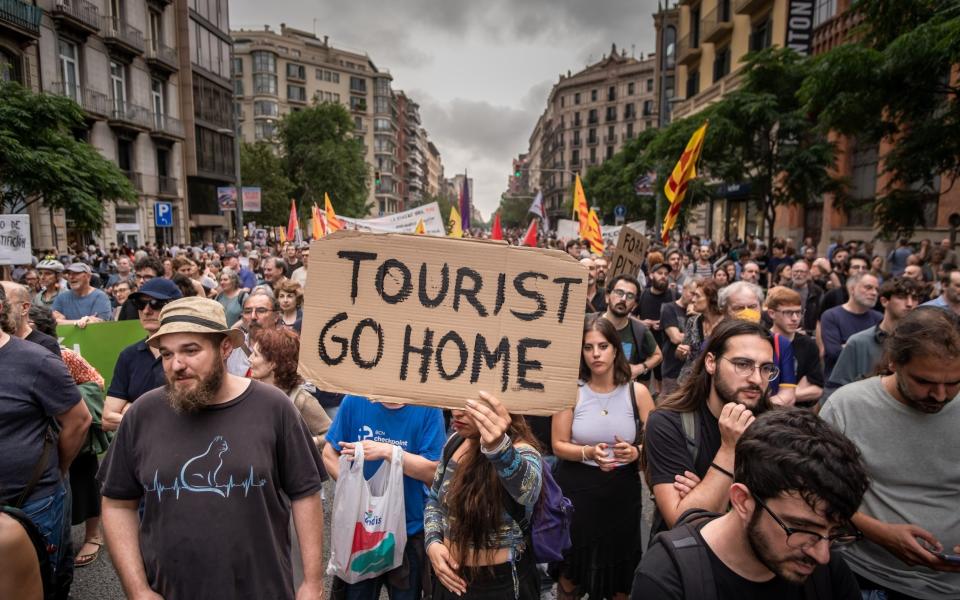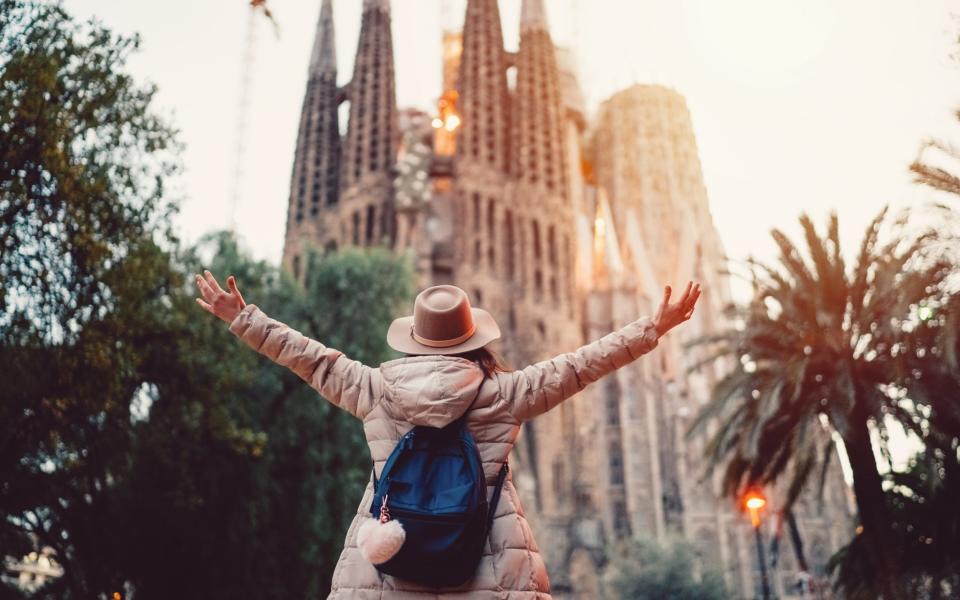‘Visitors wouldn’t dream of behaving at home the way they do in Barcelona’

Barcelona’s dizzying rise in popularity in the noughties was met, on the whole, with nothing more than bemused pride by its citizens. Tourism was the golden goose that went on to keep many bars and restaurants from going under during the financial crisis, and would provide employment for tens of thousands of people.
It’s hard to say when the tipping point was.
Maybe it was when the local trains became crowded with beachgoers, or the year when an ice cream parlour seemed to suddenly appear on every corner. Or perhaps when the handful of little family-run shops in the Ciutat Vella made way for neon-lit late-night supermarkets.
Was it around the time the bars replaced their zinc counters and fruit machines with cookie-cutter banquettes and subway tiles, and locals found they had to puzzle over an English-only coffee menu of baffling permutations when all they’d wanted was a café con leche?
In all probability, these factors played a minor role compared to the behaviour of the new breed of holidaymaker – younger, less well-off and more interested in Spain’s weather, beaches and cheap beer than in Picasso’s early doodlings or the florid architecture of the Modernistas.
Increasingly these visitors were staying in holiday lets rather than hotels. In 2019, before Covid skewed the figures, 9.5 million Barcelona tourists stayed in hotels, while four million stayed in rental apartments, many of these in otherwise residential blocks.

“It’s not tourism in itself that’s the problem,” says Barcelona resident Helena Lizari. “It’s the attitude. So many visitors wouldn’t dream of behaving at home the way they behave here. It’s as though they left the social norms of their own countries behind and treat Barcelona like it’s one big party.”
But it’s not just noise, litter or lack of respect that bothers locals. “There are fewer useful services or decent food shops in the centre now,” says Lizari. “They’ve all been pushed out for souvenir shops and restaurants that cater solely to outsiders.”
Although visitors are very unlikely to encounter direct hostility, a certain resentment is evident in the form of regular protests about overtourism, and an awful lot of graffiti of the “tourists go home” variety.
Barcelona mayor Jaume Collboni has sworn to address the problem and last week made a shock declaration – none of the city’s Airbnb or other short-term tourist rentals will have their licence renewed after November 2028.
“These 10,000 flats will be used by the city’s residents, or will be released on to the market for rent or sale,” he said. He talked about the rise in rents (up around 70 per cent) and in property prices (up around 40 per cent) over the last decade, and how difficult life had become for ordinary citizens.
The plan may come to nothing – for one thing there is no guarantee Collboni will get the second mandate that he would need in order to follow up on it. There are also various legal moves afoot to block it, with the claim that it would be an infringement of property rights, but the move does seem to herald a political shift and a desire to sort out the problems of overtourism.
It’s not the first such move – Collboni is also in talks with the port authorities about restricting cruise ships, which are dimly viewed in the city both for environmental reasons and for disgorging passengers that wander the streets but eat and drink on board, spending very little money in the city itself.

Other measures include a nightly tourist tax that can add €3 or more per person, per night, on to a hotel bill, along with restrictions at certain sites, such as a ban on large groups in the Boqueria, Barcelona’s celebrated food market.
Whether these will be enough to return tourism to good favour remains to be seen.
How to be a good tourist in Barcelona
There are easy ways to minimise your impact, such as visiting out of season, if you can (and Barcelona can be lovely in January, say, or October).
Furthermore, a lot of Barcelona’s problems come from overcrowding in certain key areas, such as the narrow streets of the Ciutat Vella, but if you head to the neighbourhoods away from the centre, you’ll find they have quite distinct characters – many of them started as discrete villages – and are infinitely rewarding for anyone wanting to explore beyond the well-worn tourist trails.

Gràcia is one such former village, subsumed by the huge growth spurt when Barcelona’s ancient city walls came down in the 19th century. Nowadays it’s an animated barrio of low-rise houses, lively squares and streets lined with quirky boutiques and indie cafés. It’s not packed with sights, but is home to one of Gaudí’s earliest buildings, the Casa Vicens. Basing yourself in Gràcia is also a good move if you’re planning to visit either the Sagrada Família or Park Güell.
Sants is another former village swallowed up with the construction of the gridded Eixample. It’s best known as the city’s major transport hub, but is increasingly carving out a reputation for cool bars and restaurants (not to mention Barcelona’s very own Nobu Hotel) and is being remodelled to feature more green spaces. As well as travellers and gastronomes, Sants is a good bet for football fans, with the Camp Nou stadium a short cab ride away.
Poblenou is the city’s former industrial zone, to the north. These days it’s a hotbed of start-ups and loft-dwelling, with a raft of stripped-down hipster cafés alongside its decades-old fish restaurants. From Poblenou it’s an easy walk to some of Barcelona’s quieter beaches. Don’t-miss attractions include the Design Museum and the Els Encants flea market with its stunning reflective ceiling. Nearby is the neo-classical Teatre Nacional de Catalunya and the Music Museum.
Poble Sec sits between the hill of Montjuïc (where you’ll find the Fundació Joan Miró – among other excellent museums) and the wildly hip barrio of Sant Antoni. Its narrow streets are speckled with humble Modernista facades, and the pedestrianised Carrer Blai functions as its prime meeting place, with dozens of terrace tables where visitors share elbow room with locals.


